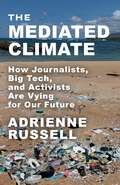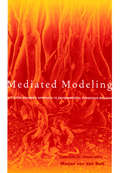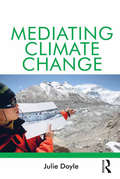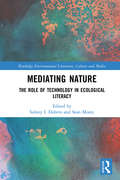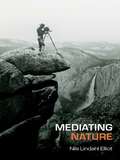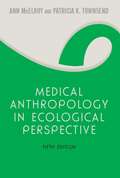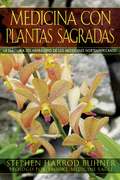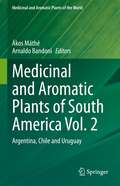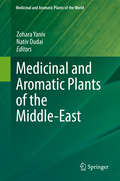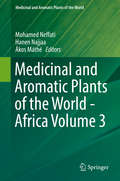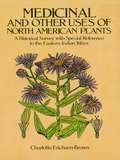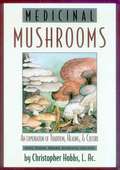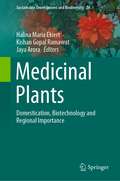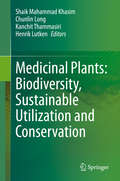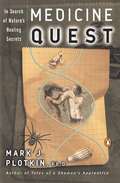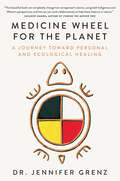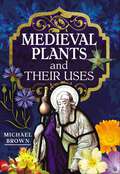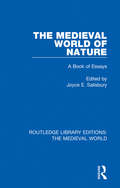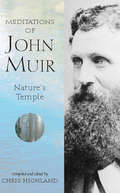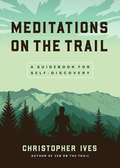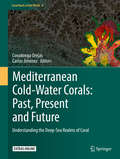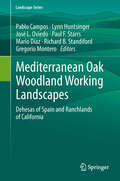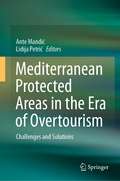- Table View
- List View
The Mediated Climate: How Journalists, Big Tech, and Activists Are Vying for Our Future
by Adrienne RussellTo what extent does journalism deserve blame for the failure to address climate change over the last thirty years? Critics point out that climate coverage has often lacked necessary urgency and hewed to traditional notions of objectivity and balance that allowed powerful interests—mainly fossil fuel companies—to manufacture doubt. Climate journalism, however, developed alongside the digital media landscape, which is characterized by rampant misinformation, political polarization, unaccountable tech companies, unchecked corporate power, and vast inequalities. Under these circumstances, journalism struggled, and bad actors flourished, muddling messages while emissions mounted and societies struggled to avert catastrophe.The Mediated Climate explores the places where the climate and information crises meet, examining how journalism, activism, corporations, and Big Tech compete to influence the public. Adrienne Russell argues that the inadequate response to climate change is intertwined with the profound challenges facing the communications environment. She demonstrates that the information crisis is driven not only by technological changes but also by concentrated power that predates the rise of digital media companies. Efforts to improve climate coverage must take into account the larger social and material contexts in which journalism operates and the broader power dynamics that shape public discourse. Drawing on interviews with journalists and activists, Russell considers the ways recent movements are battling misinformation. She offers timely recommendations to foster engagement with climate issues and calls on readers to join in efforts to reshape the media landscape to better serve the public interest.
Mediated Modeling: A System Dynamics Approach To Environmental Consensus Building
by Marjan van den Belt Thomas DietzMediated modeling is an innovative new approach that enhances the use of computer models as invaluable tools to guide policy and management decisions. Rather than having outside experts dispensing answers to local stakeholders, mediated modeling brings together diverse interests to raise the shared level of understanding and foster a broad and deep consensus. It provides a structured process based on system dynamics thinking in which community members, government officials, industry representatives, and other stakeholders can work together to produce a coherent, simple but elegant simulation model. Mediated Modeling by Marjan Van Den Belt is a practical guide to participatory modeling for both practitioners and students, one that is firmly theoretically grounded in the field of systems dynamics and environmental modeling. Five in-depth case studies describe the successful use of the technique in a variety of settings, and a final chapter synthesizes the lessons highlighted by the case studies.Mediated Modeling's step-by-step description of the techniques and practical advice regarding implementation offer a real-world solution for all those seeking to make sound decisions about the environment.
Mediating Climate Change (Environmental Sociology Ser.)
by Julie DoyleClimate change has been a significant area of scientific concern since the late 1970s, but has only recently entered mainstream culture and politics. However, as media coverage of climate change increases in the twenty-first century, the gap between our understanding of climate change and climate action appears to widen. In this timely book, Julie Doyle explores how practices of mediation and visualisation shape how we think about, address and act upon climate change. Through historical and contemporary case studies drawn from science, media, politics and culture, Mediating Climate Change identifies the representational problems climate change poses for public and political debate. It offers ways forward by exploring how climate change can be made more meaningful through, for example, innovative forms of climate activism, the reframing of meat and dairy consumption, media engagement with climate events and science, and artistic experimentation. Doyle argues that cultural discourses have problematically situated nature and the environment as objects externalised from humans and culture. Mediating Climate Change calls for a more nuanced understanding of human-environmental relations, in order for us to be able to more fully imagine and address the challenges climate change poses for us all.
Mediating Nature: The Role of Technology in Ecological Literacy (Routledge Environmental Literature, Culture and Media)
by Sidney I. Dobrin Sean MoreyMediating Nature considers how technology acts as a mediating device in the construction and circulation of images that inform how we see and know nature. Scholarship in environmental communication has focused almost exclusively on verbal rather than visual rhetoric, and this book engages ecocritical and ecocompositional inquiry to shift focus onto the making of images. Contributors to this dynamic collection focus their efforts on the intersections of digital media and environmental/ecological thinking. Part of the book’s larger argument is that analysis of mediations of nature must develop more critical tools of analysis toward the very mediating technologies that produce such media. That is, to truly understand mediations of nature, one needs to understand the creation and production of those mediations, right down to the algorithms, circuit boards, and power sources that drive mediating technologies. Ultimately, Mediating Nature contends that ecological literacy and environmental politics are inseparable from digital literacies and visual rhetorics. The book will be of interest to scholars and students working in the fields of Ecocriticism, Ecocomposition, Media Ecology, Visual Rehtoric, and Digital Literacy Studies.
Mediating Nature (International Library of Sociology)
by Nils Lindahl ElliotMediating Nature provides a history of the present nature of mass mediation. It examines the ways in which a number of discourses, technologies and institutions have historically shaped the current ways of imagining nature in the mass media. Where much of the existing research treats mass mediation as a matter of media technologies, texts, or institutions, this text adopts a somewhat different approach: it considers mass mediation as a historical process by means of which the members of audiences and indeed the public more generally came to be incorporated as observers in, and of mass culture. This approach allows the book to investigate the roles that a wide range of genres relating to nature played in constructing senses of nature but also of mass culture itself. The genres include landscape paintings and gardens, modern zoos, photography, early cinema, nature essays, disaster and ‘animal attack’ films, as well as wildlife documentaries on television. The investigation develops what Lindahl Elliot describes as a ‘social semeiotic’ approach that combines the semeiotic theory of Charles Peirce with a historical sociology of cultural formations. Topical and timely, this fascinating book will be of great interest to students and researchers in the fields of media, sociology, cultural geography and environmental studies.
Medical Anthropology in Ecological Perspective
by McelroyMcElroy and Townsend (both of the State U. of New York at Buffalo) present the fifth edition of their text introducing the field of medical anthropology. Their aim is to bring together the varied strands of medical anthropology--ethnographic studies of illness beliefs, curing rituals, and herbal medicines; study of the role of disease and climate as factors in human evolution; work on cross-cultural communication in public health; and study of human relationships to their environments in contemporary settings and in the past--using an ecological model and the concept of medical ecology. They present chapters on the ecology of health and disease; interdisciplinary research in health problems; genes, culture, and adaptation; changing patterns of disease and health; the ecology and economics of nutrition; culture, ecology, and reproduction; stress, illness, and healing; health resources in changing cultures; costs and benefits of development; and medical anthropology practices in the 21st century. Interspersed throughout are 16 "profiles" (five new to this edition): case studies that illustrate points made in the rest of the text through examples of current research in medical anthropology, with examples including demographic analysis of census data in post-Soviet Siberian villages, focus group research with inner-city teens in urban Connecticut, and a team project designed to reduce the rates of cholera in rural Ecuador. Annotation ©2009 Book News, Inc. , Portland, OR (booknews. com)
Medical Anthropology in Ecological Perspective
by Ann Mcelroy Patricia K TownsendWidespread awareness of emerging infectious diseases and global environmental change makes the ecological perspective of this premier teaching text for medical anthropology as relevant as ever. Integrating biocultural, environmental, and evolutionary approaches to the study of human health, this fifth edition is now thoroughly revised to reflect new developments in the field. Research by human biologists and paleopathologists illuminates the history and prehistory of disease, while the work of cultural and applied anthropologists addresses contemporary health issues. The fifth edition features five new profiles by guest contributors, all leading researchers on health and environment. New topics include community health and disease prevention in urban America; water-borne disease in Ecuador; iodine deficiency in the Himalaya; stress and demographic change in northern Siberia; and participatory action research in Costa Rica. Also included is updated and expanded consideration of refugee health, global aspects of HIV/AIDS, and careers in applied medical anthropology.
Medical Anthropology in Ecological Perspective
by Ann Mcelroy Patricia K TownsendWidespread awareness of emerging infectious diseases and global environmental change makes the ecological perspective of this premier teaching text for medical anthropology as relevant as ever. Integrating biocultural, environmental, and evolutionary approaches to the study of human health, this fifth edition is now thoroughly revised to reflect new developments in the field. Research by human biologists and paleopathologists illuminates the history and prehistory of disease, while the work of cultural and applied anthropologists addresses contemporary health issues. The fifth edition features five new profiles by guest contributors, all leading researchers on health and environment. New topics include community health and disease prevention in urban America; water-borne disease in Ecuador; iodine deficiency in the Himalaya; stress and demographic change in northern Siberia; and participatory action research in Costa Rica. Also included is updated and expanded consideration of refugee health, global aspects of HIV/AIDS, and careers in applied medical anthropology.
Medicina con plantas sagradas: La sabiduría del herbalismo de los aborígenes norteamericanos
by Brooke Medicine Eagle Stephen Harrod BuhnerEl primer examen en profundidad de los fundamentos sagrados del mundo del herbalismo medicinal de los aborígenes norteamericanos • Revela cómo los chamanes y sanadores “hablan” con las plantas para descubrir sus propiedades medicinales • Incluye las oraciones y canciones medicinales vinculadas con el uso de cada una de las plantas examinadas A medida que los seres humanos evolucionaron en la Tierra, utilizaron plantas para todo lo imaginable --alimentos, armas, canastas, vestimentas, refugio y remedios de salud. En su libro Medicina con plantas sagradas, Stephen Harrod Buhner analiza la relación de larga data entre los pueblos aborígenes y las plantas y examina las técnicas y estados mentales que utilizan estas culturas para comunicarse con el mundo botánico. El autor explora la dimensión sagrada de las interacciones entre seres humanos y plantas --un territorio en el que los humanos experimentamos la comunicación con las plantas como expresiones del Espíritu. Con respecto a cada planta curativa descrita en el libro, el autor presenta sus usos medicinales, normas para su preparación y elementos ceremoniales como las oraciones y canciones medicinales vinculadas con el uso de la planta.
Medicinal and Aromatic Plants of South America Vol. 2: Argentina, Chile and Uruguay (Medicinal and Aromatic Plants of the World #7)
by Ákos Máthé Arnaldo BandoniThis volume, as the seventh of the series Medicinal and Aromatic Plants of the World, deals with the medicinal and aromatic plant (MAPs) treasures of the so-called Southern Cone, the three southernmost countries (Argentina, Chile and Uruguay) of South America. Similarly to the previous volumes of the series, the main focus is to collect and provide information on major aspects of botany, traditional usage, chemistry, production / collection practices, trade and utilization of this specific group of plants. The contributors, who are recognized professionals and specialist of the domain, have collected and present state of the art information on 41 species. Most of these are not only of interest from the scientific point of view, but hold also a potential for the prospective utilization of the decreasing, occasionally overexploited / endangered medicinal plant resources of this huge continent. The book is expected to serve as a source of information also on some less known or less studied species. As such the volume is expected to support future research and public health professionals.
Medicinal and Aromatic Plants of the Middle-East
by Zohara Yaniv Nativ DudaiThe current volume, "Medicinal and Aromatic Plants of the Middle-East" brings together chapters on selected, unique medicinal plants of this region, known to man since biblical times. Written by leading researchers and scientists, this volume covers both domesticated crops and wild plants with great potential for cultivation. Some of these plants are well-known medicinally, such as opium poppy and khat, while others such as apharsemon and citron have both ritual and medicinal uses. All have specific and valuable uses in modern society. As such, it is an important contribution to the growing field of medicinal and aromatic plants. This volume is intended to bring the latest research to the attention of the broad range of botanists, ethnopharmacists, biochemists, plant and animal physiologists and others who will benefit from the information gathered therein. Plants know no political boundaries, and bringing specific folklore to general medical awareness can only be for the benefit of all.
Medicinal and Aromatic Plants of the World - Africa Volume 3
by Mohamed Neffati Hanen Najjaa Ákos MáthéThis volume in the series is devoted to Africa, a continent that possesses a vast treasure of medicinal plants and has produced some exclusive materials for the world market. This volume is expected to strengthen the medicinal plant sector in African countries by making comprehensive information on medicinal and aromatic plants available to policy-makers and entrepreneurs. It can be used to frame effective policies and create an environment conducive to the growth of the plant-based medicine industry, bringing economic benefit to African nations. It will help health organizations to improve the health of their people by using their own resources and a less expensive system of medicine, which is accepted by African society. It could also lead scientific communities to increase R&D activities in the field.
Medicinal and Other Uses of North American Plants: A Historical Survey with Special Reference to the Eastern Indian Tribes
by Charlotte Erichsen-BrownChronological historical citations document 500 years of usage of plants, trees, and shrubs native to eastern Canada, northeastern U.S. Also complete identifying information. 343 illustrations. "...this is the best Dover reprint relative to medicinal plants in fifteen years . . . you can't go wrong." -- Botanic & Herb Reviews.
Medicinal Mushrooms: An Exploration of Tradition, Healing and Culture
by Christopher HobbsMedicinal Mushrooms is a modern handbook for exploring and understanding the rich traditions of healing fungi in Eastern and Western cultures. Author Christopher Hobbs thoroughly documents and details the nutritional and health benefits of over 100 species of edible fungi. Here is the most complete work on the cultural, health-promoting, and medicinal uses of mushrooms ever published!
Medicinal Plants: Domestication, Biotechnology and Regional Importance (Sustainable Development and Biodiversity #28)
by Halina Maria Ekiert Kishan Gopal Ramawat Jaya AroraMedicinal plant research is an evergreen subject. There is a tremendous increase in popularity of herbal medicine in traditional medicine, ethnomedicine, modern medicine and as over the counter food supplements. Even after this increased demand, supply is neither uniform nor assured as most of these plants are collected from wild. In developing countries of tropical and subtropical regions where majority of herbal drugs are produced, this is not organised sector making it vulnerable to several malpractices, hence standardization of all aspects required. This has also negative impact on biodiversity and conservation of plants as well as supply of uniform material. This book is aimed to provide up to date information about sustainable use of selected medicinal plants, their active ingredients and efforts made to domesticate them to ensured uniform supply. Development of agrotechnology, biotechnology and cultivation practices using conventional and non-conventional methods are presented. Where these efforts will lead the medicinal plant research and future perspective are discussed. The chapters are written by well recognised group leaders in working in the field. The book contains topics on general biology of medicinal plants, their sustainable use and, cultivation and domestication efforts. A uniform chapter structure has been designed to keep consistency. The book will be useful for academicians, agriculturists, biotechnologists and researcher, and industries involved in manufacturing herbal drugs and supplementary products.
Medicinal Plants: Biodiversity, Sustainable Utilization and Conservation
by Shaik Mahammad Khasim Kanchit Thammasiri Chunlin Long Henrik LutkenPlants have been a source of medicines and have played crucial role for human health. Despite tremendous advances in the field of synthetic drugs and antibiotics, plants continue to play a vital role in modern as well as traditional medicine across the globe. In even today, one-third of the world’s population depends on traditional medicine because of its safety features and ability to effectively cure diseases. This book presents a comprehensive guide to medicinal plants, their utility, diversity and conversation, as well as biotechnology. It is divided into four main sections, covering all aspects of research in medicinal plants: biodiversity and conservation; ethnobotany and ethnomedicine; bioactive compounds from plants and microbes; and biotechnology. All sections cover the latest advances. The book offers a valuable asset for researchers and graduate students of biotechnology, botany, microbiology and the pharmaceutical sciences. It is an equally important resource for doctors (especially those engaged in Ayurveda and allopathy); the pharmaceutical industry (for drug design and synthesis); and the agricultural sciences.
Medicine Quest: In Search Of Nature's Healing Secrets
by Mark PlotkinIn Medicine Quest, Mark Plotkin moves beyond the Amazon rainforests of his classic Tales of a Shaman's Apprentice to describe the ongoing race to find new medicines for intractable diseases such as AIDS, cancer, diabetes, and tuberculosis in far-flung places all over the world. While highlighting the unlikely marriage of natural products, indigenous wisdom, and biotechnology, Plotkin details discoveries that are producing stunning results in the laboratory: painkillers from the skin of rainforest frogs, anticoagulants from leech saliva, and antitumor agents from snake venom. An entertaining and educational weave of medicine, ecology, ethnobotany, history, exploration, and adventure, Medicine Quest will thrill scientists, naturalists, and armchair explorers, and heighten our appreciation for the inexhaustible therapeutic potential of our natural world.
Medicine Wheel for the Planet: A Journey toward Personal and Ecological Healing
by Dr. Jennifer Grenz"This beautiful book can completely change how we approach science, using both Indigenous and Western perspectives, and how we can work collaboratively to help foster balance in nature." —Suzanne Simard, bestselling author of Finding the Mother TreeA farm kid at heart, and a Nlaka'pamux woman of mixed ancestry, Dr. Jennifer Grenz always felt a deep connection to the land. However, after nearly two decades of working as a restoration ecologist in the Pacific Northwest, she became frustrated that despite the best efforts of her colleagues and numerous volunteers, they weren't making the meaningful change needed for plant, animal and human communities to adapt to a warming climate. Restoration ecology is grounded in an idea that we must return the natural world to an untouched, pristine state, placing humans in a godlike role—a notion at odds with Indigenous histories of purposeful, reciprocal interaction with the environment. This disconnect sent Dr. Grenz on a personal journey of joining her head (Western science) and her heart (Indigenous worldview) to find a truer path toward ecological healing.In Medicine Wheel for the Planet, building on sacred stories, field observations and her own journey, Dr. Grenz invites readers to share in the teachings of the four directions of the medicine wheel: the North, which draws upon the knowledge and wisdom of elders; the East, where we let go of colonial narratives and see with fresh eyes; the South, where we apply new-old worldviews to envision a way forward; and the West, where a relational approach to land reconciliation is realized. Eloquent, inspiring and disruptive, Medicine Wheel for the Planet circles toward an argument that we need more than a singular worldview to protect the planet and make the significant changes we are running out of time for.
Medieval Plants and their Uses
by Michael BrownPlants were an essential part of medieval life. Most people lived in houses made of wood and thatch, which often accidentally burned down when they cooked their food or huddled over wood fires to keep warm. People wore linen clothing dyed with plants. They drank ale, cider and wine as they danced to music played on wooden instruments. Beauty, love and seduction could all be made easier with a few herbal preparations. If you became ill, plants provided many of the cures. The unwary may have mistaken a poisonous plant for one that was good to eat, with fatal consequence. Others may have used the poisonous plant to remove an unwanted rival. Some plants had magical properties. The mysterious mandrake could kill anybody who tried to dig it up without taking the appropriate precautions. Demons could be summoned or dismissed by the aid of plants. The church used powerful incense to clean the air and induce a sense of religious euphoria. This book is designed to give a broad introduction to the plants that were used during the medieval period. With many colorful photos, a list of plants that were available and some original medieval recipes to try, you can set out on an adventure to explore the wonderful world of medieval plants.
The Medieval World of Nature: A Book of Essays (Routledge Library Editions: The Medieval World #46)
by Joyce E. SalisburyOriginally published in 1993, The Medieval World of Nature looks at how the natural world was viewed by medieval society. The book presents the argument that the pragmatic medieval view of the natural world of animals and plants, existed simply to serve medieval society. It discusses the medieval concept of animals as food, labour, and sport and addresses how the biblical charge of assuming dominion over animals and plants, was rooted in the medieval sensibility of control. The book also looks at the idea of plants and animals as not only pragmatic, but as allegories within the medieval world, utilizing animals to draw morality tales, which were viewed with as much importance as scientific information. This book provides a unique and interesting look at the everyday medieval world.
Meditations of John Muir
by Chris HighlandEditor Chris Highland pairs 60 insightful Muir quotes with selections from other celebrated thinkers and spiritual texts. Take this pocket-size guide with you on backpacks, nature hikes, and camping trips.
Meditations on the Trail: A Guidebook for Self-Discovery
by Christopher IvesDiscover how to explore and deepen your connection to nature with a rich array of do-anywhere meditations.Meditations on the Trail offers a rich array of do-anywhere meditations that will help you explore and deepen your connection to nature, and yourself, in new ways, making the most of your time on the trail. This small book—perfect for throwing in a daypack or a back pocket as you head out for the trail—is filled with practices to take you into the heart of the natural world and uncover your most vibrant self. You&’ll return home grateful, more aware of interconnection, and maybe just a little wiser. &“For walkers of all paces and geographies, this lovely book is a helpful guide for savoring moments on the trail, and feeling how deeply related we are to all existence.&”—Stephanie Kaza, author of Conversations with Trees: An Intimate Ecology
Mediterranean Cold-Water Corals: Understanding the Deep-Sea Realms of Coral (Coral Reefs of the World #9)
by Covadonga Orejas Carlos JiménezWhat do we know about Mediterranean Cold (Deep)-Water coral ecosystems? In this book, specialists offer answers and insights with a series of chapters and short papers about the paleoecology, biology, physiology and ecology of the corals and other organisms that comprise these ecosystems. Structured on a temporal axis—Past, Present and Future—the reviews and selected study cases cover the cold and deep coral habitats known to date in the Mediterranean Basin. This book illustrates and explains the deep Mediterranean coral habitats that might have originated similar thriving ecosystems in today’s Atlantic Ocean.
Mediterranean Oak Woodland Working Landscapes
by Gregorio Montero Jose Luis Oviedo Pro Lynn Huntsinger Mario Diaz Pablo Campos Paul F Starrs Richard B StandifordThe oak tree was a boon companion as humans expanded their presence across much of the globe. While oak woodlands (Quercus spp.) come today in stunningly diverse forms, the stately dehesas of Spain and the dramatic oak-dominated ranchlands of California are working landscapes where cultivation and manipulation for a couple of millennia have shaped Mediterranean-type ecosystems into a profoundly modified yet productive environment that is sought-after by every manner of species. The grazing of wildlife and livestock in oak woodlands yields a remarkable plant and animal biodiversity, creating a mosaic of habitats and visually pleasing savannas. Added products unique to Spain such as Iberian pigs and cork, and in California multiple landowner benefits, include valued ecosystem services that allow owners, visitors, and conservation supporters to experience the benefits of woodland life. With its 15 chapters a decade in the making, this handsomely illustrated book covers key topics in oak woodland policy, ecology, and management in Spain and California, presenting new research results and reviewing an existing expert literature.
Mediterranean Protected Areas in the Era of Overtourism: Challenges and Solutions
by Ante Mandić Lidija PetrićThis book comprises studies that reflect on various influences of excessive tourism development in protected areas, and solutions designed and initiated to mitigate such challenges. A large proportion of tourism in Mediterranean destinations constitutes nature-based tourism, in particular, tourism in parks and protected areas. As a destination experiences higher intensity and density of tourism, the potential conflict between maintaining a healthy natural environment and economic development also increases. This has urged planners and decision-makers to devise and adopt innovative approaches that seek to strike a balance between tourism development and nature conservation. This book demonstrates the importance of collaboration across and beyond disciplines and of all groups of stakeholders for maximization of societal impacts and tourism-related benefits.
